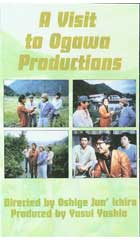
A Visit to Ogawa Productions 1981, 2001
Distributed by First Run/Icarus Films, 32 Court St., 21st Floor, Brooklyn, NY 11201; 800-876-1710
Produced by Yasul Yashio
Directed by Oshige Jun’ Ichiro
VHS, color, 62 min.
College - Adult
Agriculture, Anthropology, Asian Studies, Film Studies
Date Entered: 04/14/2005
Reviewed by Mike Boedicker, Danville Public Library, IllinoisWhat is the role of the documentary filmmaker in recording a subject? Passive observer? Or involved insider? Japanese documentarian Shinsuke Ogawa (1935-1992) believed firmly - even obsessively, he admits - in the latter. Years in the making, Ogawa’s films were produced only after he and his devoted crew immersed themselves completely in their subject. In A Visit to Ogawa Productions (shot in 1981 but not completed until 2001), Japanese director Nagisa Oshima (In the Realm of the Senses) visits the location of Ogawa’s latest project to explore his colleague’s unique and intensely dedicated approach to filmmaking.
Oshima arrives to find Ogawa working on A Japanese Village – Furuyashikimura, a feature-length documentary chronicling the seasonal cycle of rice growing in the small village of Kaminoyama, Yagamata. Ogawa has set up a filmmaking collective there, and after giving Oshima a brief tour of the rice fields, he sits down for a lengthy interview. Summarizing his filmmaking philosophy, the chatty, enthusiastic Ogawa says he tries to become an “insider” with the subject: “Being outside gives a very different view from someone standing in the field…When outside, you see it objectively. Inside it is far more subjective,” and thus, to Ogawa, more truthful. Indeed, he considers an earlier documentary he made about farming a failure because it was shot, both literally and figuratively, “outside the fields.”
In Furuyashikimura, Ogawa explains, he is seeking “to depict rice as a living organism,” a life force. Rice has its own language, and long before cameras rolled the filmmakers devoted themselves to learning that language. This meant becoming rice farmers themselves. Ogawa originally planned to spend two years on the project but didn’t start filming until three years in - it took him and the crew that long to learn rice farming. Unlike the villagers, the filmmakers eschewed farm machinery because they wanted to learn everything by hand (“I’m a nonconformist,” Ogawa cheerfully explains). They dutifully walked through the rice fields daily, even in winter, and always slowly, because “so much is missed if we move too fast. By walking very slowly, more will be revealed.” The locals thought they were nuts, Ogawa admits, but this laborious process permitted the filmmakers to become intimately acquainted with every square inch of their fields. And, in witnessing the filmmakers’ total dedication to the project, the locals eventually warmed up to the “eccentric” artists.
Though Furuyashikimura is ostensibly a two-year record of the filmmakers’ efforts to grow rice, Ogawa says the project is really a broader document about the filmmakers’ and villagers’ lives in the 1980’s. Two-thirds of the film isn’t about rice per se but about the farmers who grow it, and 80% of Ogawa’s work as a documentarian was getting to know these farmers during the lengthy preproduction process. At the time of this interview, Ogawa has been living in the village for eight years and has just started editing his film - all 75 hours of footage. Eight years might seem an exorbitant commitment for a documentary, but as Ogawa reasons, he has learned in a few years what a seasoned farmer takes a lifetime to absorb. And he refuses to apologize to those who criticize his indulgent methods: “We’re filming what interests us and we’re doing it our way.”
Though Ogawa and his collective were considered quite radical, this profile is anything but. Shot in long, static takes, it’s little more than a talking head interview. No footage from Furuyashikimura or Ogawa’s other works is included - a serious detriment when discussing any filmmaker’s work. Still, the philosophical discussions are frequently compelling, and both Ogawa and Oshima are likeable. Ogawa’s enthusiasm for filmmaking is infectious and his commitment inspiring. A Visit to Ogawa Productions is recommended for larger academic and public library collections.